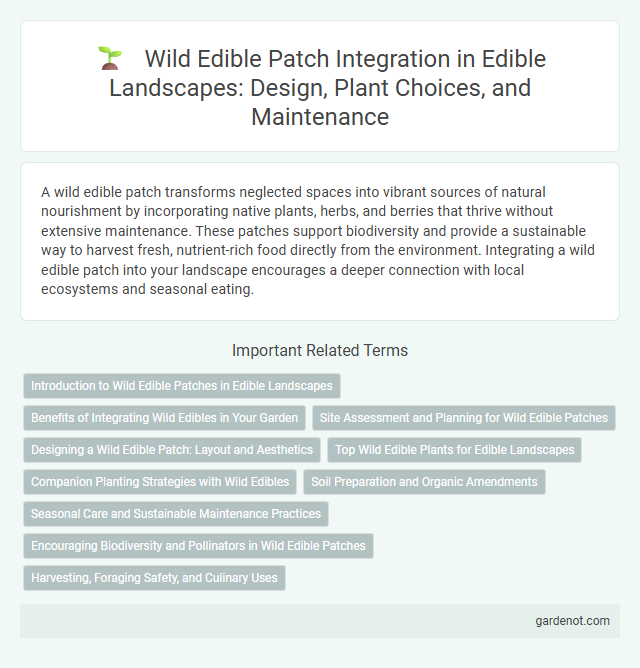A wild edible patch transforms neglected spaces into vibrant sources of natural nourishment by incorporating native plants, herbs, and berries that thrive without extensive maintenance. These patches support biodiversity and provide a sustainable way to harvest fresh, nutrient-rich food directly from the environment. Integrating a wild edible patch into your landscape encourages a deeper connection with local ecosystems and seasonal eating.
Introduction to Wild Edible Patches in Edible Landscapes
Wild edible patches incorporate native plants and foraged foods into urban and suburban landscapes, enhancing biodiversity and food security. These areas blend aesthetics with functionality, providing sustainable sources of nutrients like wild berries, herbs, and greens while supporting local ecosystems. Integrating wild edible patches promotes ecological balance by attracting pollinators and improving soil health within edible landscapes.
Benefits of Integrating Wild Edibles in Your Garden
Integrating wild edibles into your garden enhances biodiversity by attracting pollinators and beneficial insects, which supports a healthier ecosystem. These plants often require fewer resources and are more resilient to local pests and climate conditions, reducing the need for chemical interventions. Wild edibles provide a diverse and nutritious food source, promoting sustainability and self-sufficiency in your edible landscape.
Site Assessment and Planning for Wild Edible Patches
Conducting a thorough site assessment for a wild edible patch involves analyzing soil quality, sunlight exposure, and local biodiversity to determine the most suitable edible plants for the environment. Planning should include selecting native and adaptable species that support ecosystem health, considering water availability, and incorporating natural pest control methods for sustainable growth. Mapping the area and creating a planting schedule aligned with seasonal cycles enhances productivity and maintenance efficiency.
Designing a Wild Edible Patch: Layout and Aesthetics
Designing a wild edible patch involves strategic placement of native plants such as wild garlic, dandelion, and sorrel to maximize both yield and visual appeal. Incorporating natural elements like stone paths and mulch enhances accessibility while maintaining an organic aesthetic. Prioritizing diverse plant heights and textures creates a dynamic landscape that supports pollinators and encourages biodiversity.
Top Wild Edible Plants for Edible Landscapes
Wild edible patches contain nutrient-rich plants like dandelion, chickweed, and purslane, thriving naturally without cultivation. These top wild edibles provide vitamins A, C, and essential minerals, supporting sustainable and low-maintenance edible landscapes. Incorporating these plants encourages biodiversity while offering fresh, organic greens for culinary use.
Companion Planting Strategies with Wild Edibles
Wild edible patches thrive through strategic companion planting, where native wild edibles like lamb's quarters, dandelion, and purslane are paired to enhance nutrient uptake and pest resistance. Integrating nitrogen-fixing wild plants such as clover or vetch boosts soil fertility while supporting the growth of surrounding edibles like wild garlic and chicory. Effective companion planting in edible landscapes encourages biodiversity, improves soil health, and maximizes harvest yields from wild foraged greens.
Soil Preparation and Organic Amendments
Wild edible patches thrive on well-prepared soil rich in organic matter, enhancing nutrient availability and soil structure. Incorporating compost, well-rotted manure, and leaf mold improves moisture retention and promotes beneficial microbial activity essential for robust plant growth. Regularly testing and adjusting soil pH between 6.0 and 7.0 ensures optimal conditions for diverse wild edible species to flourish.
Seasonal Care and Sustainable Maintenance Practices
Wild edible patches require seasonal care tailored to the growth cycles of native plants, including pruning in early spring to encourage healthy shoots and mulching in autumn to protect roots from frost. Sustainable maintenance practices emphasize minimal soil disturbance, organic composting, and rainwater harvesting to enhance soil fertility while conserving natural resources. Regular monitoring for invasive species and natural pest control helps maintain ecosystem balance and supports biodiversity within the edible landscape.
Encouraging Biodiversity and Pollinators in Wild Edible Patches
Wild edible patches promote biodiversity by cultivating native plants that provide habitat and food sources for pollinators like bees, butterflies, and birds. Incorporating diverse species such as wild herbs, native flowers, and fruit-bearing shrubs supports ecosystem balance and enhances pollination rates. These ecosystems improve soil health and resilience, ensuring sustainable growth of edible wild plants while fostering local wildlife populations.
Harvesting, Foraging Safety, and Culinary Uses
Harvesting wild edible patches requires careful identification to avoid toxic plants, focusing on species like dandelion greens, wild garlic, and purslane known for their nutritional benefits. Foraging safety includes using clean tools, avoiding polluted areas, and harvesting sustainably to protect local ecosystems. Culinary uses of wild edibles range from fresh salads and herbal teas to sauteed greens and flavorful pesto, enhancing meals with natural, organic flavors.
Wild edible patch Infographic

 gardenot.com
gardenot.com